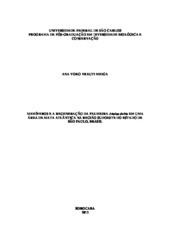Mamíferos e a regeneração da palmeira Attalea dubia em uma área de Mata Atlântica na região Sudoeste do Estado de São Paulo, Brasil
Abstract
Animals may influence the spatial distribution and survivorship of plants with which they interact. For instance, the Janzen-Connell model predict that the probability of seed and seedling survivorship is reduced around the parental plant because of the intense seed predation and herbivory in this place, which suggests the role of seed dispersal in plant regeneration. The hunting and habitat fragmentation threaten the regeneration of many plant species that depend on large animals to disperse their seeds. In this study I investigated the relationship between seed dispersion, predation and the spatial distribution and survival of seedlings of the palm Attalea dubia in native forest preserved, evaluating the importance of mammals for plant regeneration. In a second part I compared the pre-dispersal seed predation of A. dubia in three habitats: a continuous forest area, a forest fragment and a pasture. This study was undertaken in Parque Estadual Carlos Botelho , and adjacent areas in south-west of São Paulo State. The flowering and fruiting phenology of the palm was observed during a year (October 2010 to November 2011). Focal observations of fruiting palms and cameras traps allowed us to verify which species of mammals included fruits or seeds of A. dubia in the diet. Seed predation and removal experiments combined with the mapping of the spatial distribution of seedling and adult plants were taken to evaluate the importance of mammals in regeneration and test the Janzen-Connell hypothesis. Fruiting of Attalea dubia occurs throughout the year. The mammal species recorded interacting with A. dubia fruits and seeds were: Cebus nigritus, Guerlinguetus ingrami, Philander frenatus and sigmodontineous rodents. Seeds away from the parent palm were more likely to survive than seeds around the parent palm. The spatial distribution seedlings and juveniles also agree with the Janzen-Connell hypothesis. Small mammals removed most seeds to short distances, around 4 meters. Seed predation by rodents was higher in the fragment than in continuous forest and much reduced in the pasture. Predation by invertebrates was reduced in continuous forest and higher in the fragment. There was no compensation of the seed predation: seed predation by invertebrates did not increase in the absence of rodents. Mammals seems to be not essential to the palm regeneration, but they may be important for the spatial distribution of A. dubia. I suggest that the importance of small mammals, such as squirrels, to seed dispersal and plant regeneration of large-seeded plants has been underestimated. Changes in seed predation among habitats may lead to the dominance of some plant species, reducing plant diversity in the long term. The increase in abundance of A. dubia that occurs in highly disturbed areas and edges of fragments can be the result of the lower seed predation in these areas.
